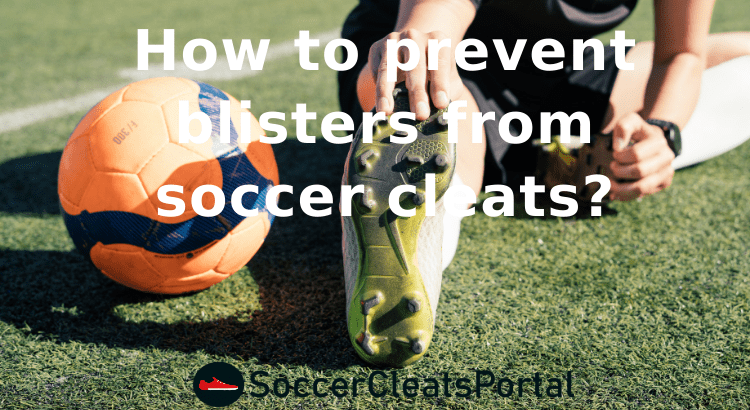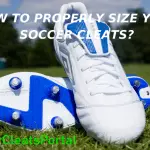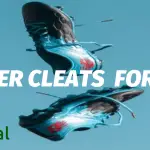Blisters are an unwelcome reality of all professions that have to spend a lot of time walking or running in their shoes. Soccer is no different, and soccer cleats are notorious for making some nasty sore spots on your feet.
So, what should you do to prevent the appearance of blisters in the first place?
- Keep Your Skin Dry and Clean.
- Wear Shoes That Fit You Well.
- Break-in The New Soccer Cleats.
- Wear Appropriate Socks.
- Adjust The Fit of Your Socks While Playing.
- Lubricate the Critical Areas on Your Feet.
- Use Soft Bandages or Blister Pastels.
- Padding With Sports Tape.
- Beware of the Field Temperature.
- Replace Old Cleats.
- Cut Holes in Your Shoes.
- Stop With Your Activities When You Feel a Blister Forming.
But firstly let’s see what is the main reason for the appearance of blisters from your soccer cleats?
What Are Blisters and What Causes Them?
A blister is a small raised portion of the skin that’s filled with body fluids. It forms on the upper layers of the skin. The fluid inside can originate from lymph, plasma, serum, blood, or pus if the blister becomes infected. However, most blisters are filled with either serum or plasma, which are clear fluids. Usually, they are shaped like circles. Depending on the cause, the amount of pain that a blister causes can differ greatly. Sometimes they will barely hurt, and sometimes they will hurt a lot.
There are many causes for blisters to form. They can form from extreme temperatures (burns or frostbite), chemical exposure, or some medical conditions. However, what interests us the most in this article is how friction in your cleats causes blisters.
Friction and Rubbing
If you are a soccer player, this will be the main cause of all blisters that you experience. If your skin is intensely rubbed, or if it’s exposed to some sort of friction for a prolonged period of time, a blister will appear. The most common cause is walking or running on long distances with old or poorly fitting shoes. Feet and hands are most susceptible to this as these extremities perform a lot of repetitive motions that can last for hours sometimes.
Another thing that can cause a problem for a soccer player is that a blister is more likely to form on damp than on dry skin. Also, blisters appear more frequently in warm environments. This means that soccer cleats provide the perfect conditions for them to form. Friction, heat, and moisture are the basic factors that cause the emergence of blisters, and soccer cleats offer the best environment for that.
Friction blisters are made when excess stress is applied between the bottom part and the surface of the skin. A certain layer of epidermis tears away from the tissues bellow and plasma from the cells leaks out. This fluid will help the new cells to form and grow into the new connecting tissue that got torn away. The solution that leaked out and formed a blister will be reabsorbed by the new cells. The swollen look of the blister should then disappear. If a blister hurts, it means that the damage of the tissues is in the deeper part of the epidermis, near the nerve endings.
Blisters in soccer cleats
In your soccer shoes, the blisters will most commonly appear due to:
- Wearing a new pair of cleats, or the cleats that are in poor condition.
- Wearing socks that don’t fit your feet that well or if the sock is slipping on the base of the insole that can lead to excessive slippage.
- Overworking in long training sessions.
- Playing on hard ground surfaces that put more stress on your feet.
When it comes to soccer cleats, you can typically get blisters in all kinds of different spots. But, blisters will mainly form in the part of your feet which is not stable and slide inside your foot such as the heel area or at the bottom of the big toe.
But, what can you do to prevent blisters from appearing on your feet?
Best Tips for Avoiding Blisters
Wear Shoes That Fit You Well
If you wear soccer cleats that aren’t appropriate for your foot, you will experience a lot of blisters.
So if you can manage to get yourself a pair of boots where you get no pressure points that also prevent your foot from sliding around inside of it and rubbing against the heel you are in the right way.
Shoes that are too big will allow your foot to move around when walking and running. This, of course, causes a lot of friction.
If your shoes are too small, your skin will be under a lot of stress from the cramped space. After wearing cleats that are like this for prolonged periods, blisters are certain to form.
You can read more in my article on how to properly size your soccer cleats.
Break-in The New Soccer Cleats
While it is always tempting to wear your new soccer cleats immediately after purchasing, you should try to avoid that.
New shoes always need some time to adapt to the shape of your foot and especially soccer cleats which are very tight by nature.
It is always advisable to wear your cleats for a few small training sessions, and then try to wear them for longer training sessions of full matches.
In any case, having a second pair of cleats that are already broken, is always advisable when you thinking of wearing your brand new shoes.
Replacing Old Cleats
Similar to wearing cleats that don’t fit you well, wearing worn-down cleats can also lead to blister problems. If the fabric of your shoe gets torn on the inside, it will provide a major friction point in your shoe.
After running for a long time in a training session, this spot will get sore easily and you will get blisters. Even worse is that when you put on your shoes next time, that same spot will get irritated again and your blisters could get really painful. Try to change your cleats when you notice discomfort due to how old they are.
Need advice on how to make your cleats last longer? You can refer to my article How to Prevent Your Soccer Cleats From Ripping
Wear Appropriate Socks
Usually overlooked, socks can also play a huge part in causing or preventing of blisters. When you are getting blisters just all of a sudden and your boots seem to be perfectly comfortable it’s probably not the fault of your boots it’s the fault of your socks.
Common socks are usually very thin and that increases the friction with the insole of the shoes resulting in the appearance of blisters.
The socks should allow the moisture from your feet sweating to get wicked away from the skin. So investing in a proper pair of socks is a good measure to keep you away from blisters.
Grip socks are a good example of socks that can help you avoid blisters as they have grip elements that reduce the slide of your feet inside the shoe, thus resulting in lesser friction.
A good idea is to wear a polypropylene sock pair under the one that’s made from cotton. By doing this, the cotton sock should absorb moisture. Two pairs of socks will also do a better job of reducing friction than only one pair would. However, beware of wearing bulky socks, as they can fold inside the cleat and create some friction points on your skin.
Adjust The Fit of Your Socks While Playing
As we have seen, socks play a huge part in the formation of blisters.
You must try to make sure that your socks feel and look perfect on your feet when you first put them on meaning that there’s no excess material bulging out anywhere. You want to make sure that everything is perfectly smooth so that when you put your boots on the sock remains perfectly smooth inside.
But what will inevitably happen is that your socks will eventually fall down or maybe right up a little bit causing some kind of a bunch of material typically around the heel area of your foot. That excess of material will create more friction and combined with sweat and hit will lead to blisters.
So, when you start running around and you feel any kind of shift in your socks meaning a bunching of material, take a few seconds, stop playing and adjust your socks.
Keep Your Skin and Shoes Dry and Clean
Well, we talked about how friction is the main cause of blisters that appear on your feet. If your feet are wet, the friction on the surface of your skin increases. This creates the perfect conditions for the blisters to form.
Also, if you keep your feet clean, you will lower the chances of any blister getting infected, so they will heal faster even when they form.
Regarding the soccer cleats, you can read more in my article on how to dry your soccer boots.
Lubricate the Critical Areas on Your Feet
A good idea when trying to prevent blisters is to treat the areas that you consider to be at risk before you put on your cleats.
You can use a lubricant like Vaseline or a bar of soap to rub the more prone parts of your foot before putting on your socks and cleats. Using powder is also a nice solution. This will reduce a lot of friction. You can also apply some ice on the spots that feel sore after taking your cleats off.
Use Soft Bandages or Blister Plasters
You can use adhesive moleskin or some other type of soft bandages. This will provide some cushion and relieve some of the friction.
You can also combine the previous tip with padding the lubricated area with bandages.
Just be careful that the bandage is applied securely. If it isn’t, it could have a reverse effect and create even more stress on the sore area.
For more cushioning, you can use blister plasters, that act as a second skin, creating a moist healing environment.
Padding With Sports Tape
Applying sports tape as soon as you feel a hot spot is always a good measure to prevent the formation of a blister.
The tape will remove some of the friction and the rubbing between your heel and the boot. Also, because of the shock-absorbing capabilities, they take away some of the pressure points on your heel or even under the foot.
Just make sure the area where your hot spot isn’t sweaty before padding with the tape.
Beware of the Field Temperature
It sounds impossible at the first glance, but it’s possible to get some light burn blisters when playing on artificial turf. On a hot summer day, the terrain absorbs heat and it can get even hotter than the outside temperature. Take extra care in these conditions as the blisters will be very likely to form.
Cut Holes in Your Shoes
Although not very advisable, this is a technique used by some of the most famous soccer players such as Phelipe Coutinho and Sergio Ramos. Of course, they can afford to buy numerous shoes every year, so cutting holes on them isn’t much of a problem as with recreational players.
The reason why they are doing this is that soccer boots fit quite tight and the one thing that really irritates a blister is pressure against it. So in the case of the heel on your football boot if you cut a giant hole, there would be nothing pressing against your blister allowing you to play comfortably.
If you are comfortable with cutting holes in your cleats and already have blister problems, that might be a solution for you.
Stop With Your Activities When You Feel a Blister Forming
If you start to feel some pain or discomfort in any area of your foot, it’s best to stop what you are doing to check it out.
You know is only gonna get worse over time, so stop your training session take the boots off and take a break and wait till the next day to start again. If you ignore the discomfort and continue with your training, it’s very likely that a blister will form.
In the case of playing in a match and you are feeling those early stages of a blister coming on obviously that’s a little bit of a different situation. if it’s a very important match and you don’t want to come off if you choose to play padding the spot with soft bandages and lubricants will help you deal with the early developing stages of a blister.
How Should You Take Care of Blisters?
Generally, it takes at least a week for a blister to heal up properly and even then it’s still gonna hurt a little bit. But if you get a bad enough blister there is going to be a two to three-week injury until your feet feel normal or at least you can wear your boots comfortably.
Τhe issue here is that the time that it takes to actually develop the blister doesn’t hurt quite as much as the time after once it starts to heal. That’s why so many people end up with blisters even though they were totally avoidable.
The best way to avoid a blister is not to let it happen in the first place. Prevention and observation are the keys as blisters are not instant injuries and may take a while to form and they do not just pop up out of nowhere.
But if they appear after all what should you do if you still get a blister? What is the best method for treating them?
These are the main guidelines when taking care of blisters:
When The Blister Hasn’t Popped
Probably, when you see that a blister has formed on your feet, your first urge would be to pop it as soon as you can. However, unless it’s really huge, you shouldn’t try to drain your blister with the hope that the body will reabsorb the fluid. As we mentioned above, the fluid inside the blister is used by the new cells to multiply and heal the sore spot. Drain the blister would more likely create an open wound susceptible to infection.
Also, you should leave it uncovered, or just cover it with a loose bandage. Always try not to put pressure on the blister. If it’s on a bad spot on the bottom of your foot, you can apply donut-shaped moleskin on the blister.
For Blisters That Already Popped
Firstly, you should wash the blister area with warm water and gentle soap. You shouldn’t use alcohol, iodine, or hydrogen peroxide. Try to smooth down the flap of skin that was left behind. Antibiotic ointment should also be applied to the area. Finally, The blister should be covered with a loose sterile bandage.
If you have to pop a huge blister, always make sure to clean your hands and the needle that you are using. A needle can be sterilized with some alcohol and water. With a sterile gauze pad, remove the fluid out of the blister. Then cover the area with antibiotic ointment and a sterile bandage.
Other Useful Tips
There are many small tips for dealing with blisters. It can be useful to combine these with the two methods mentioned above.
– When protecting the blister with a bandaid, always make sure that the blister has room to breathe.
– When you are at home it’s a great idea to remove the bandages and help the blister breathe so it can dry up more quickly.
– Change the bandage daily whenever it gets dirty or wet.
As we have seen the healing period is between 2 to 3 weeks. If you have a game that you must play or if the blisters start to form during a match what would you do is to try padding the hot spot as much as possible with bandages, tapes, or blister plasters while lubricating the spot enough to reduce the friction.
Final Thoughts
The appearance of blisters is the most common injury that’s caused by soccer cleats that everybody at one point or another has experienced in their soccer-playing career.
Blisters are in my opinion a type of injury that is 100% avoidable given that you follow certain steps as mentioned above.
If you have found other ways that helped you get rid of those nasty spots feel free to share them in the comment section below.




